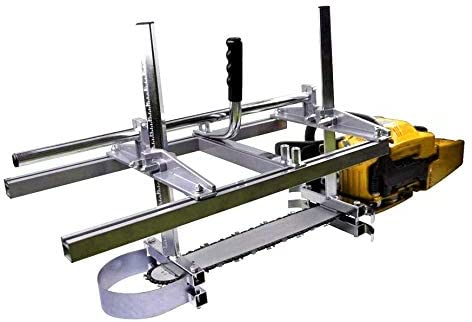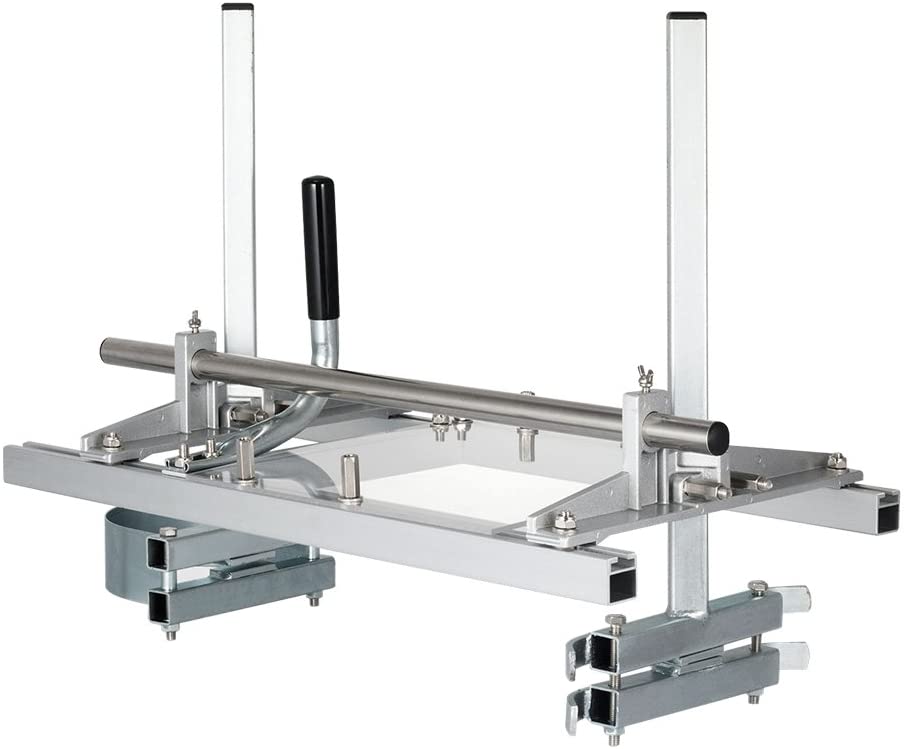- Husqvarna 562xp Review and Guide: Is It Worth Buying? - December 8, 2023
- Ego Pole Saw Review and Guide: Is It Right For You? - May 1, 2022
- Best Mini Chainsaws Guide: How to Choose the Right One? - May 1, 2022
When you look around, it seems like everything is somehow made of wood. The floors we walk on, homes, furniture, and uniquely built architecture all made from wood! If you are curious about sawmills and the process of using them safely, then this is the perfect sawmill and milling guide for you!
The evolution of sawmills and mills has made mills work efficiently and safely. Sawmills from the past were not only dangerous but required their workers to have strength.
Physical strength is not a qualification anymore, as modern sawmills today are highly computerized, which has allowed sawmills to keep up with lumbers high demand.
What is a Sawmill?
The term sawmill has two definitions. A sawmill can mean the location where lumber is produced; this can also be called a lumber mill. This is a facility where they process logs and turn them into lumber.
Sawmills move at an efficient rate to produce high volumes of lumber. In order to keep up with their high demand, they use modernized saws. Before sawmills, boards and planks were made manually either by a handsaw or a whipsaw.
The second definition of a sawmill refers to a saw or cutting machine that can take a log and turn it into lumber.
The sawmills today are motorized, resulting in producing lumber that keeps up with timbers’ high demand. Modern sawmills are programmed to cut any dimension or length—this best known as dimensional lumber.
Dimensional lumber is a common term used amongst builders to continue consistent size amongst all construction used with lumber.
What do Sawmills Produce?
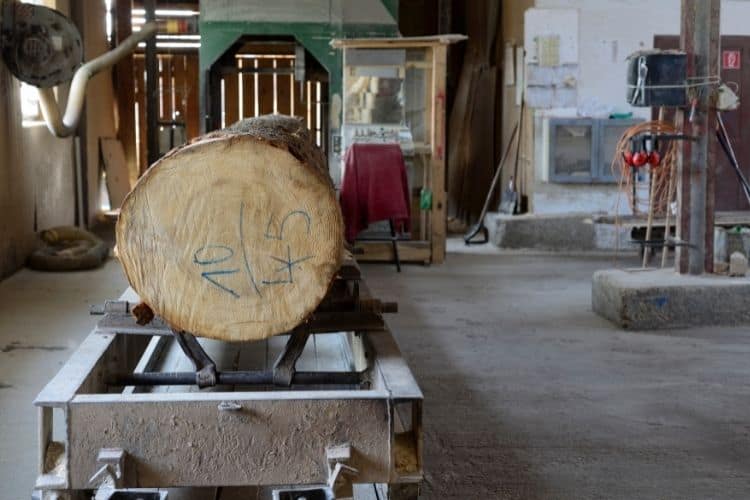
Today, sawmill locations are large commercial operations that can employ hundreds of employees that work around-the-clock shits in order to produce premium lumber. Commercial sawmills specialize in processing softwoods and hardwoods.
- Softwood species used are pine, spruce, cedar, redwood, and hemlock. This type of wood is best for residential construction.
- Hardwood species used are cherry, oak, walnut, beech, and maple. Hardwood is best used when building furniture, flooring, and wooden panels.
Not only can you purchase specific wood for your construction product, but sawmills also hold premade products in all shapes and sizes. Due to the high demand for lumber, sawmills must have a production line. A sawmill company relies heavily on its production line to maintain quality and consistency in all lumber products.
How do Sawmills Operate?
Despite what you might think, the sawmill’s basic operation is similar to how it was a hundred years ago! The process begins with a log that enters on one end, and when it reaches the other side, it turns into dimensional lumber, also known as timber.
Timber is wood that is processed from a log turned into beams and planks. But before we even get the log on the sawmill, these steps must be completed:
- Trees are selected to be harvested
- After the trees are selected, they then have men climb the trees and cut the limbs down. This process is known as limbing.
- Logs are then placed on logging trucks, where they are driven to the sawmill.
- Upon arrival at the mill, logs become debarked. This process takes off all of the bark on the log, leaving it bare.
- When logs are debarked, they are then entering the decking phase. Decking is known as the process of organizing the logs by species, size, and use.
- Then a woodworker uses a head saw, which makes the first cuts into the log, creating unfinished logs that will be processed later on.
- Based on the species and quality of the log, it is broken down by a lumber edger. This makes the surface of the wood smooth and gives the logs a dimensional shape.
- After the log has gone through the edger, this will result in having four-sided lumber
- The lumber will then be trimmed based on what dimensions are needed. Dimensional lumber is selected by thickness and width. The thickness can range from 2 to 5 inches and width from 2 to 12 inches. Some common dimensions used are for rater application, studs, plates, and headers.
- After the wood is processed, the lumber is kept in an air-dried environment, known as a kiln.
This process is extensive, but with a successful production line, these steps can be completed efficiently. During a production line, sawmills keep a fast pace giving each employee a task.
Breaking down the sawmill and milling process makes it evident that there goes a lot into processing wood. It is much more than just chopping down a tree.
To own and operate a successful sawmill, it takes understanding the intensive process. Successful sawmills work around the clock to keep up with high demand while also maintaining timber quality.
Sawmills not only do common cuts, but upon request, they make specialized shapes and cuts. This allows customers to receive unique furniture or architecture not seen in everyday homes.
What Kind of Sawmills are Used?
There two types of sawmills used, they are called stationary and portable sawmills. These sawmills can range from all kinds of sizes that are either placed or mounted on a foundation.
It is more likely a fixed structure permanently set in a building or garage if it is a stationary sawmill, while a portable sawmill may be on trailer or truck mounted.
Stationary Sawmill
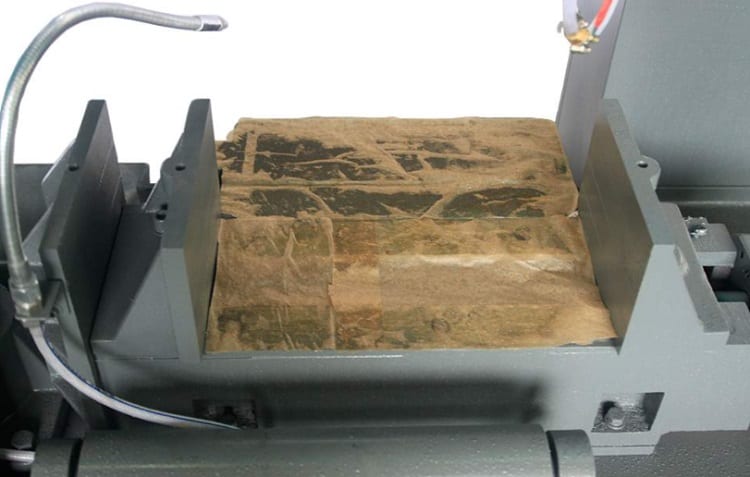
Each sawmill is designed for its intended purpose. Using a stationary sawmill is the most common tool for lumber production, as it has been historically the most suitable type of sawmill to use.
Traditionally, you will see a stationary sawmill located somewhere under a roof. This is done so production cannot be stopped by mother nature.
Back in the day, to effectively run a sawmill, it had to be powered by steam power. Because of steam power, most lumber mills were built near a water source, which created a reliable and renewable water source.
Water is not a requirement today, as modernized stationary sawmills are not run by steam power, creating freedom for lumber production anywhere!
Stationary sawmills tend to be much larger than portable sawmills. The reason for the size difference is because stationary sawmills tend to be used for processing large logs. These logs can weigh up to 15 tons!
That is why having a primary stationary sawmill is vital for any sawmilling business to have. This makes it crucial if you have a large company to own a stationary sawmill that can handle any size log!
Pros
- High production levels
- Production in any condition
- Great for commercial facilities
Cons
- Larger, taking up more space
- Non-transportable
- The mill must bring logs.
Portable Sawmills
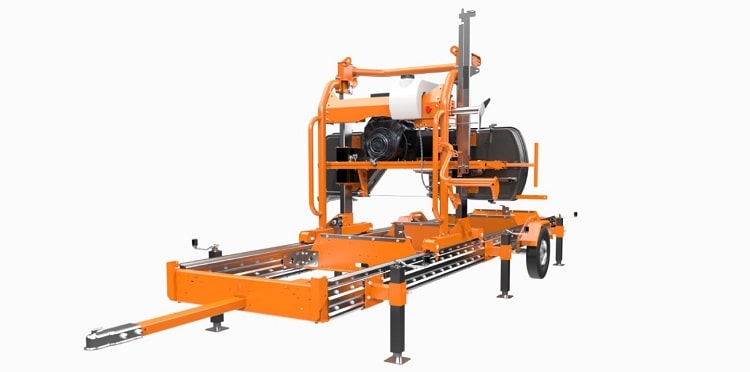
Portable sawmills are usually smaller sawmills used for personal or professional use. Each model is made for different uses and designed to complete various functions. Portable sawmills are best used for those who are looking for sawmilling with convivence. These sawmills are best known for their ability to be moved from location to location.
Their popularity stems from bringing the sawmill to the logs and allowing lumber to be processed in remote areas. Moving the sawmill to any place has made it possible for communities to use it after natural disasters or rebuild their communities after fallen trees.
Homeowners who may own land could benefit from having a portable sawmill on their property. Sawmills are an essential tool for people to maintain their land from having trees damaged by storms, insects, or animals.
Portable mills are also a benefit for those who enjoy an excellent DIY project. Having access to a portable sawmill creates the opportunity to build all sorts of items requiring cutting lumber.
Types of Portable Sawmills
- Swing blade sawmills: Swing blade sawmills are unique for having a movable head on a track that cuts a log. It uses a circular blade with a kerf range from 0.20 to 0.30 inches. The con of using this portable sawmill is that it takes several people to help transport and operate this machinery. The primary purpose of this sawmill is its efficiency at cutting speed.
- Chainsaw mills: Chainsaw mills are small enough to fit in your hand! They only need one or two operators, but they were made to cut wood in desolate areas, giving loggers the ultimate opportunity to have a sawmill wherever they go! A basic chainsaw mill is a steel guide bracket attached to a chainsaw bar. Some chainsaw mills have a track and frame system that can be mounted to a chainsaw for easy use! Some downsides of chainsaw mills are the kerf range 0.40 inches, slower than other mills, and creates jagged cuts.
- Band mills: Band sawmills is known for their saw head with two band wheels placed on a frame that guides the saw head into the log. This kind of portable sawmill ends up producing the smallest kerf between 0.06 to 0.12 inches. These types of portable sawmills are easy to operate, quick set up, and extremely transportable. You will find that operations of all sizes own band mills, as it tends to be the happy medium between a swing blade sawmill and chainsaw mill!
Having a portable sawmill does not have to be expensive because the prices range from $2000.00 to $80,000. Depending on the project and the amount of production you are looking to do, portable sawmills today are made in all shapes and sizes to fit everyone’s needs!
Portable sawmills run off of gas or diesel engine, allowing work to be done remotely with no electricity. This is great for those who need to process lumber on-site with a lack of resources!
Pros
- They run off of gas or diesel
- It can be used in small areas or dense forests
- Easy to transport
Cons
- Lack of cutting speed
- Rough cuts
- Weather can affect production
Stationary Vs Portable Sawmills
Stationary sawmills are made for the high production of lumber, primarily used in commercial facilities. These machines are great for producing a wide range of consumer products that sawmills provide for their customers.
The stationary machines they have in their facilities are designed for manufacturing large quantities of lumber while maintaining energy costs and reducing labor.
To maintain the volume of production, sawmills rely on their equipment to fully function at all times. If a sawmill machine is down, it could lose a company thousands of dollars.
That is why all machines must be maintained! Stationary sawmills are designed to process large logs at high rates, whereas portable sawmills cannot produce timber efficiently.
Portable sawmills were created for those to mill anywhere! This tool was designed to create an easy transferable tool to mill in the most desolate locations. Portable sawmills create the perfect opportunity for production to continue, even in the deepest of woods.
Not only that, but portable sawmills are an essential tool for homebuilding and land maintenance. This tool gives homeowners the ability to fix or build anything their heart desires! Stationary sawmills are heavy and take many people to operate, while portable sawmills are meant for one or two people to use.
The Most Popular Portable Sawmills
We know that having a portable sawmill is helpful for many different purposes, but for some, they lack the knowledge on where to start looking for the perfect portable sawmill for their needs.
The selection is large, with many claiming they are the “best” sawmill to use. To help create a quick buying sawmill guide, here are some of the best ranked portable sawmills available today!
The TimberKing 1220
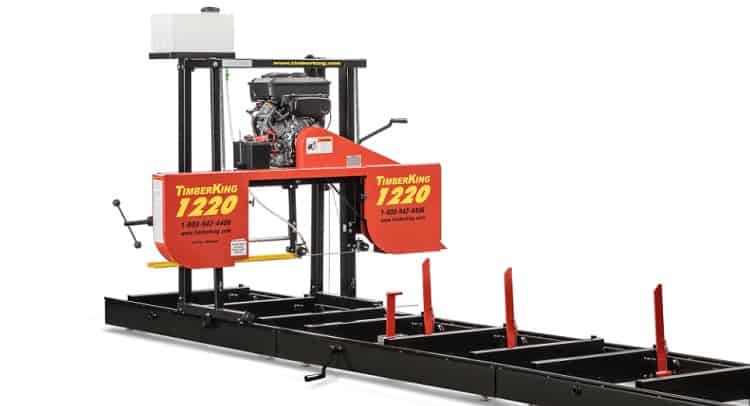
TimberKing is known for the quality of its portable equipment. Their portable sawmill models are sturdy, reliable, and made for numerous jobs! This portable sawmill is made with such quality that it can be used for industrial or home use.
Reviews praise this machinery for its high-powered features, and the professional feel the welded masterpiece gives you!
Built to last, the TimberKing 1220 is Made-in-USA with many different features. Some features include: Massive sold-welding steel cutting deck, 23HP V-Twin Made in USA Electric-start, Big Capacity-handles logs up 33″ in diameter, up to 17′ 9″ long, and much more!
Pros
- Convenient
- Sturdy
- Reliable
Cons
- Hefty price tag, but this machinery holds its value
D&L 180SB
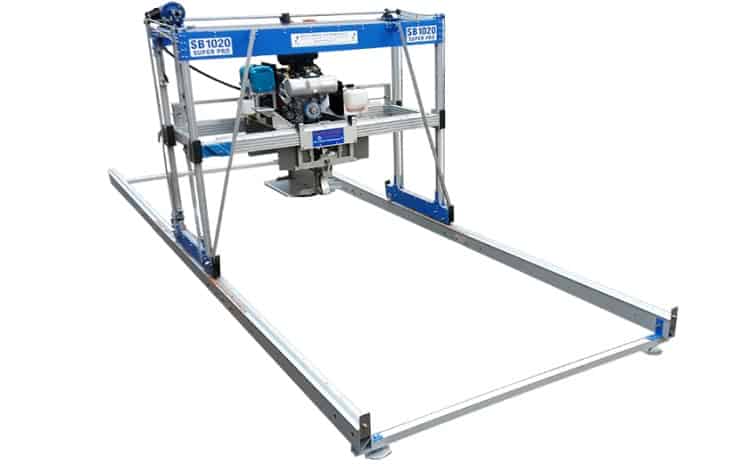
D&L prides itself on building innovative products made for advanced wood processing. They are best known for their Swing Blade technology used on their current portable sawmills. Their business has over 68 years in the industry with a guaranteed 730-day warranty on all their products.
The D&L 180SB is one of the world’s most versatile portable sawmills with a cutting capability of 180 degrees. The machine is made of up stainless steel, giving their customers the ultimate relief with buying a product that guarantees stability and power during each task.
Some of these exciting features this product provides 6″ up to 60″ log diameter, unlimited log length, no log turning, electric start, 180-degree swing, radial multi ketch and bevel siding attachments, and much more!
This product is the perfect portable sawmill to have for industrial building and DIY use! The stainless-steel frame guarantees a product that will last years while continuing to help you create high-quality lumber.
Pros
- Carbide blade
- Double cut factory warranty
- Lightweight
Cons
- High price tag
LumberPro HD36V2
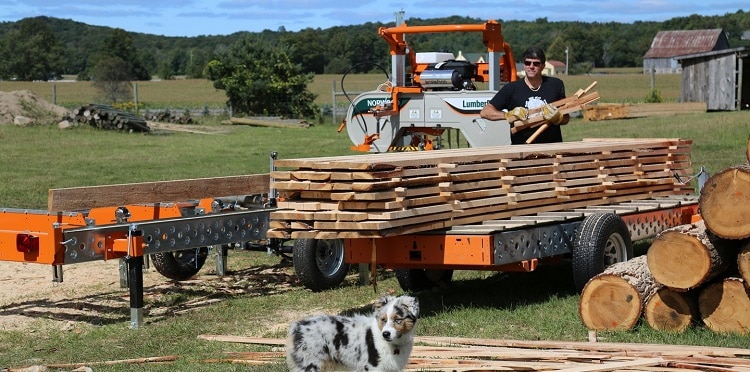
Norwood Sawmills believe quality is the most important part of building a reliable and consistent sawmill product. They represent legendary products that guarantee to handle your most challenging jobs!
Their premier products hold high standards of strength and durability, creating one of the most efficient portable sawmills that you can get your hands on!
The LumberPro HD34V2 is the perfect solution to mold any softwood or hardwood into quality lumber. This machine is one of the strongest and smoothest mills that are made today! The sawmill is made with cutting-edge technology, guaranteeing your satisfaction with the product and your lumber!
Some of the features this product gives you a log diameter of 36″, a width of cut 31″, can go from manual to hydraulic, accurate milling, ability to handle large logs, 240-volt motor, 23 horsepower, and much more!
Pros
- Customizable
- Huge Capacity
- Offers manual and hydraulic features
Cons
- Accessories for products are a bit overpriced
- Does not offer electric start
LT15 Portable Sawmill
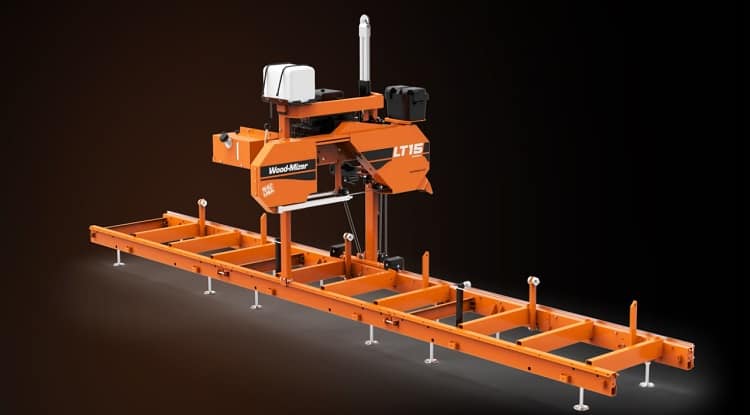
Wood-Mizer is one of the most popular brands in the milling industry. They are best known for building portable sawmills that are versatile, reliable, and easy to use!
The LT15 portable sawmill is no doubt a great producer of sawmills that are built to last. Their products are aimed at customers of all skill ranges. Whether you are a lumber expert or a customer just getting into a DIY build, then this is the perfect machine for you.
The portable sawmill is customizable, allowing you to change features for each project. Some unique features that this sawmill has are optional diesel/gasoline/electric start, 28″ log diameter, 26″ width of cut, 17-foot 8-inch log length, lift-assist, and optional extensions.
Pros
- Customizable
- Gasoline, diesel, or electrical engine
- Lift-assist
Cons
- Crank feature
- Log length
The Most Popular Stationary Sawmills
For those looking at adding a stationary sawmill to your home, this sawmill guide is directed towards helping you find the best products for creating quality lumber.
There are many brands to choose from, but these are the most reliable stationary sawmill for your use!
Band Sawmill LX250
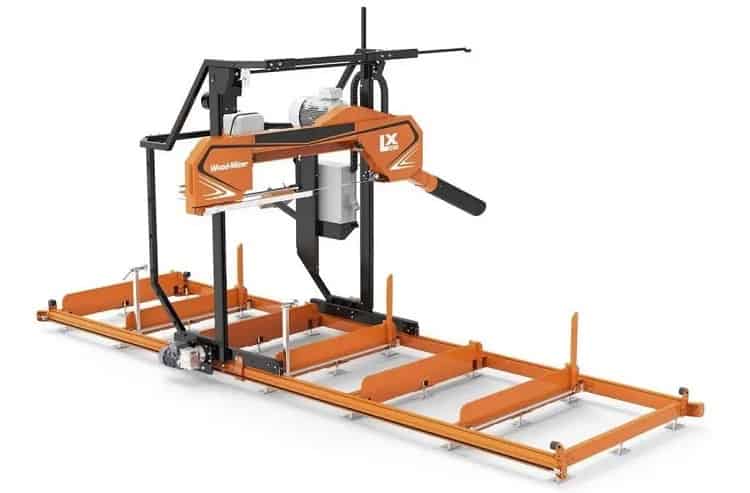
The Wood-Mizer offers reliable portable sawmill equipment, but they provide stationary sawmills meant for any carpenter!
Their equipment is built to handle any product that their customer needs to be done. This stationary sawmill stands out in the rigid LX frame that gives the machine a stable structure, guaranteeing consistent, high-quality lumber.
The band sawmill LX250 is different from the rest, as it can be used for wide logs up to 140 cm in diameter. This stationary sawmill is European-crafted machinery ready to take on any task!
The modular bed holds 3 sections, each offering extension for sawing long logs. 3 side supports, then secure the logs, 2 manual clamps, followed by an area for a forklift to lift logs easily onto the bed.
Pros
- Forklift accessibility
- The dual ability for commercial or home use
- Electric
Cons
- Difficult to transport
- It takes a lot of space
Semi-Automatic Double-column Horizontal 12 “×17” 5HP Band Saw 230V 3PH
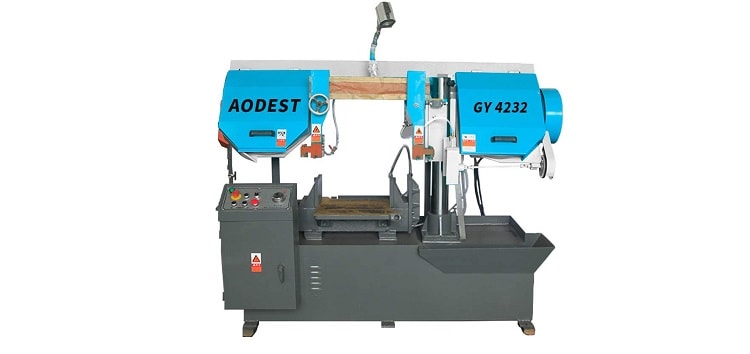
This semi-automatic stationary sawmill is a carpenter’s dream. This is an excellent addition to anyone’s garage or commercial business! Best known for its cutting-edge speed along with a double-column structure giving you a stable machine for logs of any size.
The band saw 230V uses hydraulic pressure and manual adjustments for convenient operation. This machine has unique features: wire brush for chip removal, speed control by belt pulley, 12″ log diameter, and much more!
Pros
- Cutting of various sized material
- Manuel adjustments
Cons
- 3300lbs
- Short bed
Bolton Tools 15 3/4″ Dual Column Band Saw GK4240
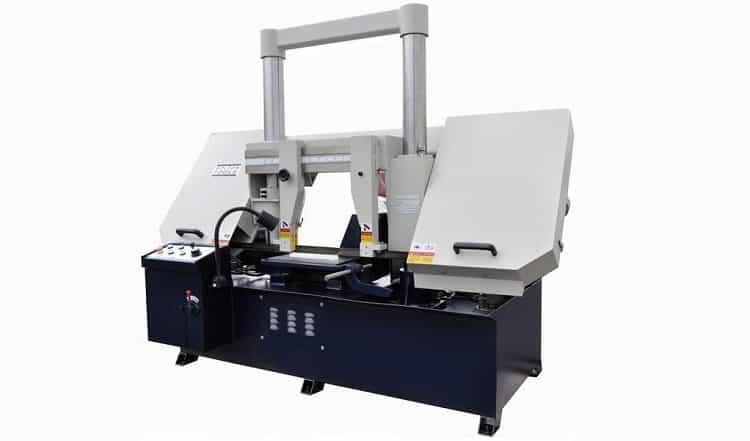
Bolton tools are an industrialized company focused on making machinery for commercial use, but this no doubt could be used in a barn or large garage. This sawmill is excellent for logs of any size, making any project possible!
This sawmill guarantees top-notch cuts and access to a stable table. Some other features: hydraulic variable speed, 230V/460V, and max cutting range 15 3/4″. This machine is built for efficiency with an adjustable feeding speed.
Pros
- Cutting rage 15 ¾.”
- Adjustable feeding speed
Cons
- Size
- Price
Amazon Picks
Who knew you could find sawmills on Amazon! Amazon sells a variety of portable sawmills at an affordable price. However, you sacrifice some convenience and quality.
These mills are designed to be used with a chainsaw for maximum portability. This trade-off is perfectly acceptable; for others, the more expensive, higher-quality options would be a better choice.
I choose these picks based on reviews, price, and overall portability. Knowing that these sawmills aren’t the same quality as others and are suited for those needing a budget option. I wanted to make sure to find the best bang for your buck1
Carmya Portable Chainsaw Mill
Carmya’s primary sells their chainsaw mills and accessories on Amazon. For an affordable price, you get a decent quality portable sawmill that will get the job done, in most cases anyway.
This portable sawmill features steel and aluminum construction that can cut beams or lumber from 0.5 inches to 13 inches thick and 36 inches wide. It fits a chainsaw with a 14” to 36” bar.
Unfortunately, this sawmill is manufactured in China, which has led to some complaints of lower-quality materials. Guide bars are not included either; they are purchasable from the same manufacturer but will run an extra $120. Overall for the price, this portable sawmill is perfect for hobbyists who aren’t looking to process anything too crazy. Keep in mind its limitations, and it will serve you well.
Pros
- Inexpensive
- Highly portable, made for use with a chainsaw. Allowing you to decide the power you need.
- Lightweight and adjustable
- Also available in the 14 to 48-inch size as well.
Cons
- Made in China
- Complaints of missing pieces and poor assembly instructions
- Guide bars cost extra
- Lower-quality material compared to other mills.
HyHydro Portable Chainsaw
The HyHydro Portable Chainsaw Mill comes in at a lower price and a completely different setup (depending on the model) than the Carmya, but I honestly prefer it. Not only do you have the option between three different sizes, but the materials are a bit higher quality in comparison.
This sawmill features aircraft aluminum and stainless steel construction and works chainsaws ranging from 45cc to 85cc. Just remember to make sure that your chainsaw fits; it’s designed for those with a bar less than 36”. You have the choice of 14”-24”, 14”-36” and 14”-48”, for future proof sake, it’s not a whole lot more to go with the bigger size.
Also, keep in mind that rails aren’t included, and you’ll have to buy or make some yourself. I’ve also heard that you can use a ladder as a rail system. But, you might want to double-check that advice.
Pros
- Inexpensive even for the biggest model
- Made of high-quality aluminum
- Available in three sizes for every hobbyist
- Easy to Assemble
Cons
- Often comes with missing pieces hindering or stopping assembly completely
- Made In China
- Measurements may be off
Granberg Alaskan Mark-IV Chainsaw Mill
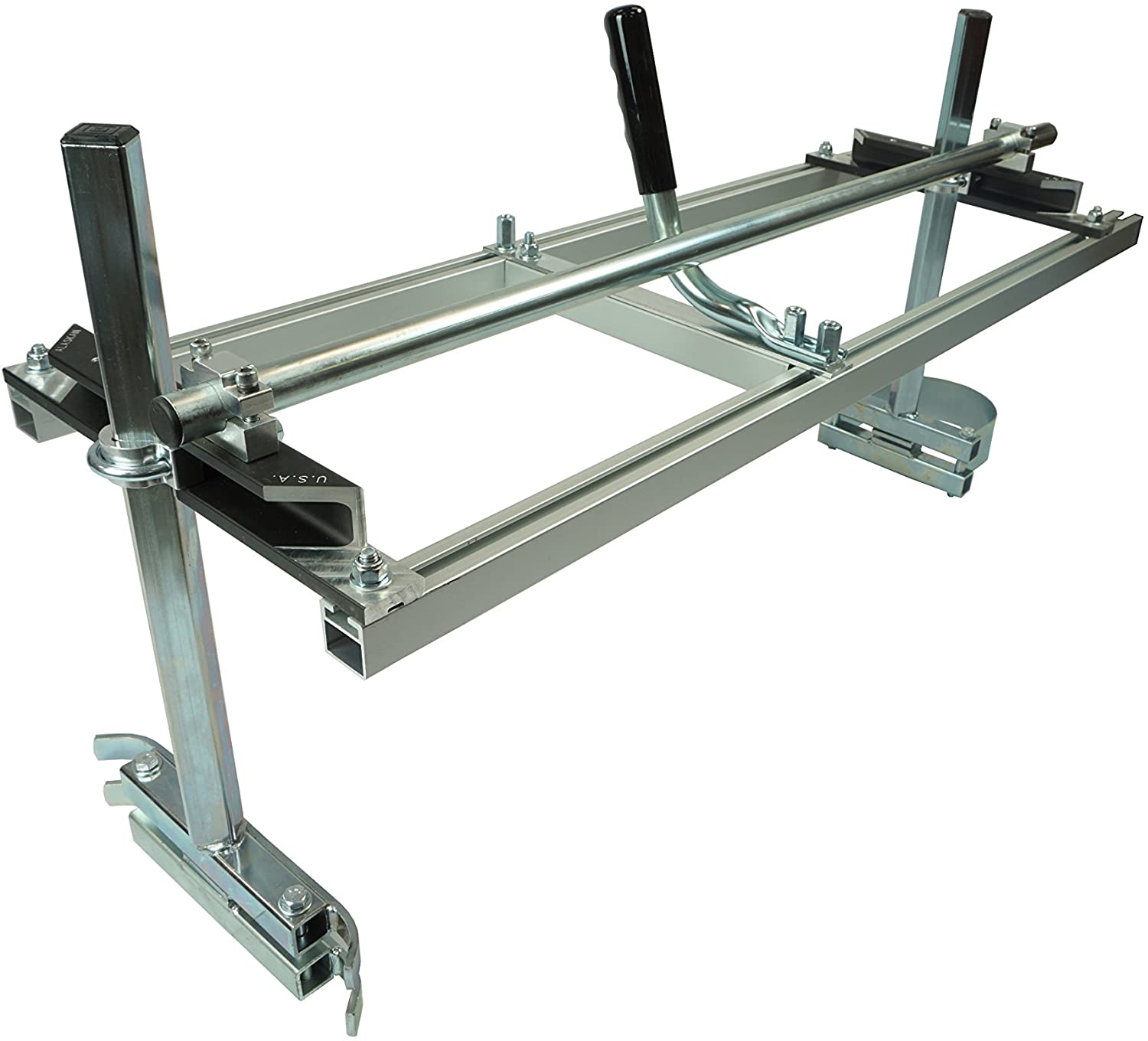
If you are looking for the highest quality Chainsaw Mill on Amazon, then look no further. This mill is manufactured in the USA and made from high-quality steel and aluminum construction. With its 36-inch wide and 13inch deep cutting limit, It’s not capable of cutting slabs as significant as other options, but it’s made from higher quality materials.
It’s lightweight, coming in at only 20lbs, making it perfect for anyone who needs something portable or simply something they can quickly move around the garage. The best part, for the price, you will receive both the chainsaw mill and a rail set; no need to hunt down or make your own with this purchase!
Make sure your chainsaw has a 36” or less bar and operates at 70cc or more. If you are looking for a smaller or bigger version, they sell options as small as 24” up to 84” on their website!
Pros
- Made in the USA
- Made from tubular aircraft aluminum and zinc-plated steel
- Easy to assemble and sturdy
- New end brackets make adjustments and cutting more accurate
- A variety of sizes is available on their website for every operation.
- Rails included in price
Cons
- Quality control is questionable when buying through Amazon
- Missing washers and bolts are common
Safety Tips: Sawmill Edition
A lumber mill or any place a sawmill in use can be a dangerous work environment. However, if you follow these basic safety tips, this will help avoid any potential common injuries.
- Wear safety equipment at all times: goggles, hard hat, boots, and gloves.
- Inspect equipment before use: each piece of equipment must be inspected for any visible signs of wear or out-of-service repairs.
- Keep hands clear: make sure you never use your hand to unclog any machinery with a blade.
- Be aware: make sure you are aware of the equipment you and others are using. Don’t be afraid to speak up if you see someone not using a machine correctly.
Following these few safety tips will lead you to a safer milling experience!
FAQ’s about Sawmilling
Question: How Does a Sawmill Work?
Answer: A sawmill machine is used to process a raw or rough log and turn it into smooth finished lumber.
Question: How to Choose Between a Portable or Stationary Sawmill?
Answer: To know which sawmill is best for you, you must determine what projects you plan to complete with it. If you are interested in producing timber at a commercial level, it is suggested that you purchase a stationary sawmill.
These sawmills are made for long-term use and are built to last hours of use. In contrast, portable sawmills are directed towards personal use, DIY projects, and milling in remote locations.
Question: What is the Best Portable Sawmill?
Answer: Our choice would be the LumberPro HD36V2. This machinery is easy to transport and built to handle commercial or personal use. Out of all of the sawmills, we find that this sawmill was built for lifetime use, giving you the most bang for your buck!
Conclusion
The sawmill and milling guide is jam-packed with information for those with little to no experience in the milling industry. As you can see, there are many steps to the milling process, but to ensure that you get the best value for your sawmill, we made sure to show you products built to last.
So, enjoy your next project, and don’t forget to stop back for any other questions!
Continue reading related Sawmill and milling guides and reviews:

